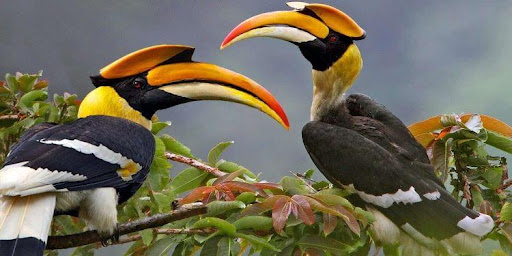The Indian Hornbill or Indian Grey Hornbill is a common type out of the different species of hornbills. It lives in India and is most arboreal. It often is part of a pair and has a grey feathered body, with a belly that is either dull white or light grey. The flight feathers are darker brown with a white tip and that tail has a white tip too. Its recognisable medium-sized horn is dark grey or black and the casque extends to where the horn starts to bend. The male’s casque is larger than the female. Females have a bill that has yellow as well as black. It has eyelashes and a red iris. It is one of the few of its type that will be spotted in cities, on large trees along the avenues.
Where is Hornbill Bird?
You can find the Indian hornbill bird in the Himalayan foothills and south going to the west and the east with the Indus systems and the Ganges delta. It can sometimes head to drier parts and as mentioned has been seen in cities with the large avenue trees. They have been seen in Himachal Pradesh, Dharamsala in both the rainy and summer seasons. It is a great one for bird spotters who cannot get out away from the city for a while!
Nesting and behaviour
These hornbills have a call that is like a squeal! They are heavy during flight so they have to flap as well as glide. They are actually more social than many hornbill birds as they can usually be found in pairs or small groups. Their nesting season as between the months of April and June and when they lay it is between one to five eggs. They will make their nests in the hollow of tall trees and they will work on a hollow to get it just right. The female will then get in and seal it up so that there is just a vertical slit that is large enough for the male to feed her through. Inside the nest, she will moult the flight feathers and keep her eggs warm. The make will provide bark pieces and food. As the checks reach maturity the female’s flight feathers regrow. Then they break out of the nest.
It has been found in studies that the Indian hornbill bird eats fruits, insects and some some small creatures, birds, molluscs, reptiles and such. The main fruiting trees they feed from include the Cansjera rheedi, Grewia tiliaefolia, Carissa carandas, Streblus asper, Lannea coromandelica and Securinega Ieucopyrus. They are also able to eat the fruits from the Thevetia peruviana which are actually toxic to a lot of other creatures. While they do mostly stay up high, sometimes they will come down to get fruit that has fallen, to get mud pellets to seal the nest opening with, or to bathe in the dust. They like to interact with each other, sometimes in the form of aerial jousting and sometimes by bill-grappling.














